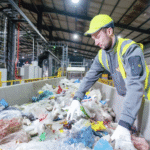Solid-State Batteries: Revolutionizing Energy Storage with Enhanced Safety and Performance
Solid-State Batteries: Revolutionizing Energy Storage with Enhanced Safety and Performance
The shift towards sustainable energy solutions is propelling advancements in energy storage technologies. A key focus in this domain is solid-state batteries (SSBs), which are poised to outperform traditional lithium-ion batteries in terms of safety, energy density, and longevity. By replacing the liquid electrolyte with a solid one, SSBs address several limitations of current battery technology, making them a critical component in the future of electric vehicles (EVs) and renewable energy systems.
Solid-state batteries utilize solid electrolytes to facilitate ion movement between the anode and cathode. This fundamental change eliminates the flammable liquid electrolytes found in conventional lithium-ion batteries, significantly reducing the risk of leaks and fires. The solid electrolyte is non-volatile and can withstand higher temperatures, enhancing the overall safety profile of the battery. This is particularly crucial for EVs, where battery safety concerns have been a barrier to widespread adoption.
One of the most significant advantages of SSBs is their potential for higher energy density. The solid electrolyte allows for the use of a lithium metal anode, which has a much higher capacity than the graphite anodes used in traditional batteries. This could result in batteries that are lighter and more compact but can store more energy, effectively increasing the driving range of electric vehicles and the efficiency of portable electronic devices. Higher energy density also means fewer charges are needed, extending the battery’s lifespan and reducing the environmental impact associated with battery production and disposal.
In addition to safety and energy density, solid-state batteries offer improved longevity. The solid electrolyte is less prone to forming dendrites—tiny, tree-like structures that can cause a battery to short circuit and fail. This enhances the battery’s life cycle stability, allowing it to endure more charge-discharge cycles without significant degradation. For grid storage applications, this means more reliable and durable energy storage solutions that can better support the integration of renewable energy sources like solar and wind power.
However, despite these promising advantages, several challenges need to be addressed before solid-state batteries can be commercially viable. Manufacturing processes for SSBs are currently more complex and costly than those for traditional batteries. Issues such as finding suitable solid electrolyte materials that offer high ionic conductivity at room temperature and ensuring good interface contact between the electrolyte and electrodes are subjects of ongoing research.
In conclusion, solid-state batteries represent a significant leap forward in energy storage technology by focusing on enhancing safety, energy density, and longevity. Overcoming the existing technical and manufacturing challenges is essential for their widespread adoption. As research and development efforts continue, solid-state batteries have the potential to revolutionize the energy storage industry, playing a pivotal role in the global transition to sustainable and environmentally friendly technologies.
Jincheng (Michael) Duan


